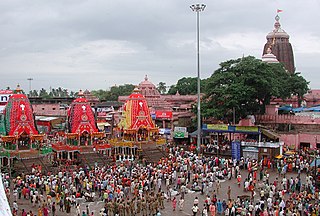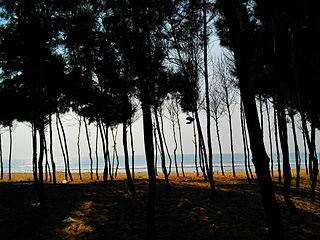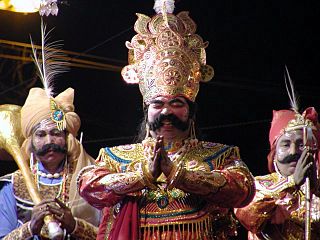Arts and architecture in India have had their course shaped by a synthesis of indigenous and foreign influences that have consequently shaped the course of the arts of the rest of Asia, since ancient times. Arts refer to paintings, architecture, literature, music, dance, languages and cinema. In early India, most of the arts were derived Vedic influences. After the birth of contemporary Hinduism, Jainism, Buddhism, and Sikhism arts flourished under the patronage of kings and emperors. The coming of Islam spawned a whole new era of Indian architecture and art. Finally the British brought their own Gothic and Roman influences and fused it with the Indian style. They have a culture infusion in their art.

Newar or Nepami, are the historical inhabitants of the Kathmandu Valley and its surrounding areas in Nepal and the creators of its historic heritage and civilisation. Newars form a linguistic and cultural community of primarily Indo-Aryan and Tibeto-Burman ethnicities following Hinduism and Buddhism with Nepal Bhasa as their common language. Newars have developed a division of labour and a sophisticated urban civilisation not seen elsewhere in the Himalayan foothills. Newars have continued their age-old traditions and practices and pride themselves as the true custodians of the religion, culture and civilisation of Nepal. Newars are known for their contributions to culture, art and literature, trade, agriculture and cuisine. Today, they consistently rank as the most economically and socially advanced community of Nepal, according to the annual Human Development Index published by UNDP. Nepal's 2011 census ranks them as the nation's sixth-largest ethnicity/community, with 1,321,933 Newars throughout the country.
Bargarh is a city and municipality in Bargarh district in the state of odisha in India. It is the administrative headquarters of Bargarh District. Bargarh is popularly known for intensive cultivation of 'paddy', therefore called "Bhata Handi" of odisha.

The Ratha Yatraof Puri, also rendered as the Ratha Jatra is a Hindu festival associated with the deity Jagannath held at Shri Khetra Puri Dham in the state of Odisha, India. It is the oldest Ratha Yatra, whose descriptions can be found in Brahma Purana, Padma Purana, the Skanda Purana, and the Kapila Samhita. This Ratha Yatra is the celebration of the occasion of the deity Jagannath, a form of the Hindu deity Vishnu or Krishna, journeying towards his aunt's house. Adherents mark this occasion as Jagannath's annual visit to the Gundicha Temple via Mausi Maa Temple near Saradha Bali, Puri.
Buddhism in Nepal started spreading since the reign of Ashoka through Indian and Tibetan missionaries. The Kiratas were the first people in Nepal who embraced Gautama Buddha’s teachings, followed by the Licchavis and Newar people. Buddha was born in Lumbini in the Shakya Kingdom. Lumbini is considered to lie in present-day Rupandehi District, Lumbini zone of Nepal. Buddhism is the second-largest religion in Nepal. According to 2001 census, 10.74% of Nepal's population practiced Buddhism, consisting mainly of Tibeto-Burman-speaking ethnicities, the Newar. However, in the 2011 census, Buddhists made up just 9% of the country's population.

Hinduism is the main and largest religion of Nepal. In 2006, the country declared itself a secular country through democracy; still, some special privileges were given to Indic religions like "The Constitution of Nepal has established a call for the protection of this age-old religion referring to Sanatan Dharma throughout the country". According to the 2011 census, the Hindu population in Nepal is estimated to be around 21,551,492, which accounts for at least 81.34% of the country's population, the highest percentage of Hindus of any country in the world. The national calendar of Nepal, Vikram Samvat, is a solar Hindu calendar essentially the same to that widespread in North India as a religious calendar, and is based on Hindu units of time. Nepal remained the last Hindu country in the world until 2008, after the abolition of monarchy in the nation.

Matsyendranātha, also known as Matsyendra, Macchindranāth, Mīnanātha and Minapa was a saint and yogi in a number of Buddhist and Hindu traditions. He is traditionally considered the revivalist of hatha yoga as well as the author of some of its earliest texts. He is also seen as the founder of the natha sampradaya, having received the teachings from Shiva. He is especially associated with Kaula Shaivism. He is also one of the eighty-four mahasiddhas and considered the guru of Gorakshanath, another important figure in early hatha yoga. He is revered by both Hindus and Buddhists and is sometimes regarded as an incarnation of Avalokiteśvara.

Puri district is a coastal district of the Odisha state of India. It has one sub-division, 11 tahasils and 11 blocks and comprises 1722 revenue villages. Puri is the only municipality of the district. Konark, Pipili and Nimapara are the three NACs in this district. Satyabadi, Gop, Kakatpur and Brahmagiri are major semi-urban areas.
The Odia (ଓଡ଼ିଆ), formerly spelled Oriya, is an Indo-Aryan ethnic group native to the Indian state of Odisha who speak the Odia language. They constitute a majority in the eastern coastal state, with significant minority populations in neighboring Andhra Pradesh, Chhattisgarh, Jharkhand and West Bengal.
Anandapur is a town and a municipality of Kendujhar district in the state of Odisha, India.

The Maa Sarala Temple is a Hindu temple in the district of Jagatsinghpur, Odisha, India. It is one of the eight most famous Shakta shrines of Odisha.
This article lists the traditional festivals and other cultural events in the Odisha region of India. Odisha celebrates 13 festivals in 12 months as the saying goes Bāra Māsare Tera Parba.
Odisha is one of the 28 states of India, located in the eastern coast. It is surrounded by the states of West Bengal to the north-east, Jharkhand to the north, Chhattisgarh to the west and north-west, Andhra Pradesh to the south and south-west. Odia is the official and most widely spoken language, spoken by 33.2 million according to the 2001 Census. The modern state of Odisha was established on 1 April 1936, as a province in British India, and consisted predominantly of Odia-speaking regions. April 1 is celebrated as Odisha Day.

Dhanu Jatra or Dhanu Yatra is an annual drama-based open air theatrical performance celebrated in Bargarh, Odisha. Spread across a 8 km radius area around the Bargarh municipality, it is world's largest open air theater, one that finds a mention in the Guinness Book of World Records. It is based on mythological story of Krishna, and his demon uncle Kansa. Originating in Bargarh, in the present day play, the enactments of the play are being performed in many other places in Western Odisha. The major one of these is the original one at Bargarh. It is about the episode of Krishna and Balaram's visit to Mathura to witness the Dhanu ceremony organized by their (maternal) uncle Kansa. The plays start with the dethroning of emperor Ugrasena by the angry prince Kansa, over the marriage of his sister Debaki with Basudeba, and ends with death of Kansa, and Ugrasen restoring back to become the king. There is no written script used in these enactments. During this festival Kansa can punish people with penalty for their mistakes. Biju Patnaik, the former Chief Minister of Odisha was fined once along with his ministers. The department of Culture of the Government of India has accorded National Festival status to Dhanu Yatra on November 2014.

The practice of Hindu animal sacrifice is mostly associated with Shaktism, and in currents of folk Hinduism strongly rooted in local popular or tribal traditions. The practice declined during the formation of Hinduism as Hindu scriptures like the Puranas and the Bhagvad Gita forbid animal sacrifice.
Kalasi Jatra or Kailasi Jatra is a Hindu festival observed in the Boudh, Subarnapur and Balangir district of Kosal region of Odisha, India. This festival is celebrated on the holy month of Kartika. During this festival the goddess is taken out from the worshiping centre to outside in a big musical procession. The devotees pray the goddess and the celebration takes place until late night. It is considered a festival of tribal origin and emphasizes the fact that the Kosal region is known for its Shakti and tantric culture.

Ratha Yatra, or Car festival, is any public procession in a chariot. The term particularly refers to the annual Ratha Yatra in Odisha, Jharkhand, West Bengal and other East Indian states, particularly the Odia festival that involve a public procession with a chariot with deities Jagannath, Balabhadra, Subhadra and Sudarshana Chakra on a ratha, a wooden deula-shaped chariot. Ratha Yatra processions have been historically common in Vishnu-related traditions in Hinduism across India, in Shiva-related traditions, saints and goddesses in Nepal, with Tirthankaras in Jainism, as well as tribal folk religions found in the eastern states of India. Notable Ratha Yatras in India include the Ratha Yatra of Puri, the Dhamrai Ratha Yatra and the Ratha Yatra of Mahesh. Ratha Yatra of Guptipara and Santipur Hindu communities outside India, such as in Singapore, celebrate Ratha Yatra such as those associated with Jagannath, Krishna, Shiva and Mariamman. According to Knut Jacobsen, a Ratha Yatra has religious origins and meaning, but the events have a major community heritage, social sharing and cultural significance to the organizers and participants.

Surendra Nath Jena created an entirely new Odissi dance style with an oeuvre of many compositions. This dance style incorporates the various aspects of Indian culture, such as temple sculpture, ancient dance, Sanskrit and vernacular literature, yoga, traditional painting, manuscripts, and philosophy. The entire music and dance choreography of these compositions were by Jena himself.

Gandabahali is a village in Sinapali block in the south of Nuapada District in Odisha, India.










